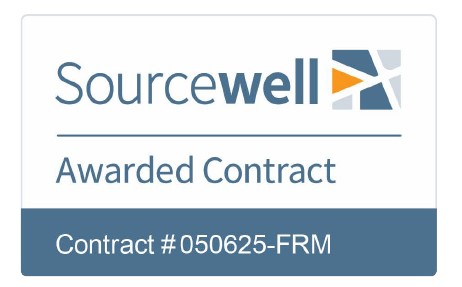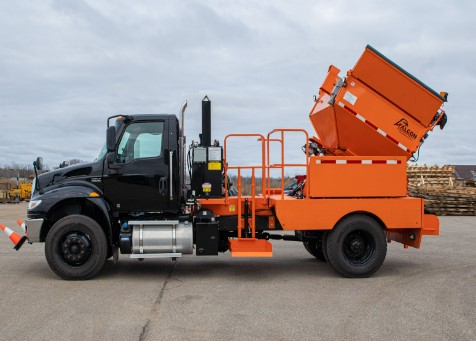Asphalt patching is essential in maintaining roadways, parking lots, and other paved surfaces. Patch trucks are the de facto workhorse used by many municipalities and patching operations thanks to their efficiency and cost-effectiveness.
The downside to traditional asphalt patching trucks is that they require a CDL license to operate. Hiring CDL workers is difficult because there are few out there, and if you do find one, you’ll need to pay them a higher salary.
Non-CDL asphalt patch trucks are the answer to this costly problem. Non-CDL patch trucks look and operate the same as traditional ones. However, they weigh less than 26,000 pounds, which is the cutoff for requiring a CDL license.
Read on to learn more about Falcon non-CDL asphalt patch trucks, their features, and the benefits they will add to your patching operation.
CDL Requirements
Part of the reason why CDL drivers are so expensive to hire and somewhat challenging to find is that it’s not easy to become one. The FMCSA (Federal Motor Carrier Safety Administration) Safety Act of 1986 sets forth the requirements for obtaining a CDL license.
All applicants must first apply for and receive a Commercial Learner’s Permit (CLP). This enables them to legally drive a commercial motor vehicle while being supervised by an instructor.
To apply for a CDL, applicants must:
- Have a valid non-commercial driver’s license
- Be at least 21 years old (if transporting hazardous materials or driving across state lines)
- Have proof of citizenship and residency
- Pass all background checks
- Pass an intensive medical examination
- Provide a statement that certifies they’re not subject to disqualification as per FMCSA 383.51
- Pass a state-approved written test and road test
Competition to hire CDL drivers is relatively intense and often results in very high salary and benefits packages. Many municipalities and smaller patching operations often cannot afford to offer competitive salaries and benefits commensurate with what large corporations will pay.
How Non-CDL Asphalt Patching Trucks Work
The FMCSA requires all trucks that weigh 26,001 lbs or more to have a driver with a CDL license. Falcon non-CDL asphalt patch trucks weigh under 26,000 lbs—meaning anyone with a valid standard driver’s license can operate them.
How is that possible?
For starters, a Falcon non-CDL patch truck does not utilize an auger or conveyor belt like a traditional one. Instead, Falcon uses a gravity dump to deliver the material to the patch site.
Augers, conveyors, and the hydraulics used to run them are extremely heavy. The lack of those parts allows the Falcon patch truck to weigh less than 26,000 lbs.
Benefits of a Falcon Non-CDL Asphalt Patch Truck
In addition to not requiring a CDL license, Falcon non-CDL asphalt patch trucks have a user-friendly design that offers several other benefits, such as:
Faster material delivery
Traditional patch trucks that utilize an auger and conveyor belt are limited in the quantity of material and speed they can deliver it due to their significantly smaller unloading opening. This can substantially slow down worker productivity and cause each patch job to take longer.
Falcon non-CDL asphalt patch trucks have the largest delivery doors on the market. This means workers have the flexibility to determine how much material they want and at what speeds they will get it. Those same large doors also allow for easier access to the hopper for cleaning.
Lowered lifetime cost
Falcon non-CDL asphalt patch trucks are more cost-effective than their counterparts, thanks to the lack of hydraulics, augers, and conveyor belts. Fewer components mean fewer things that can break down in the future.
Another significant cost saver is that you won’t have to hire an expensive driver with a CDL license. If that driver should suddenly resign or call in sick, you’d be scrambling to find someone qualified to drive a CDL truck.
More fuel efficient
Because Falcon non-CDL asphalt patch trucks do not have hydraulic motors or pumps to turn an auger, they also burn less fuel. That adds up to significant cost savings over an 8-hour shift.
Fewer trips to the asphalt plant
Workers also have the option to hold material overnight, which allows them to start working immediately the next day instead of waiting in line at the asphalt plant—which might be located on the other side of town—in rush hour traffic.
Fewer moving parts
Due to not having an auger, hydraulic pump, or conveyor belt, Falcon non-CDL asphalt patch trucks have fewer parts than their traditional counterparts. This directly translates into increased uptime availability and lower maintenance and operating costs over the truck’s lifetime.
Sufficient capacity
Non-CDL asphalt patch trucks from Falcon have an 8,000 lb carrying capacity—which is more than enough material to be held at the optimum temperature.
High-quality
One of the most significant benefits of the Falcon non-CDL asphalt patch truck is that it uses the same guts, hopper, and tack tank as their other highly popular and durable hotboxes, trailers, and recyclers.
Your choice of truck
The Falcon non-CDL asphalt patch truck requires a class 6 truck. You can supply your own truck or choose from one of seven different models that we’ll provide:
- Ford F750
- Freightliner MD6 106
- Hino 268A
- International MV
- Kenworth T270
- Mack MD6
- Peterbilt 536/7
The size, brand, options, etc. of the truck we supply will determine the final cost. If you have a different brand truck than listed above, call us and we’ll help you figure out if we can make it work. We’re more than happy to consider alternative truck options.
Non-CDL Asphalt Patch Truck Required Maintenance
Falcon non-CDL asphalt patch trucks require very little maintenance compared to their traditional counterparts. However, basic maintenance requirements are the same as other patchers, including burner and battery maintenance, keeping the hopper clean, and truck upkeep.
Falcon Non-CDL Asphalt Patching Trucks
Falcon non-CDL asphalt patching trucks will save you time, money, and headaches in the long run. They’ll increase productivity and efficiency while reducing the need for expensive maintenance and operators. Click below to learn more.



Recent Comments